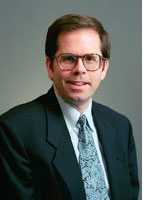 Musical Mosaics: Piecing Together a Commission
Musical Mosaics: Piecing Together a Commission
Timothy Kramer
Composer in Residence
Trinity University
When I was asked to compose a new work for the Midwest Clinic, I was surprised and intrigued. As a composer who had not previously written works for band, I remember discussing it with one of my colleagues at Trinity University in San Antonio, who reminded me that the Midwest Clinic was one of the largest music conferences in the world and that if I ever wanted to write for the wind band, this was like starting at the top.
John Whitwell, a member of the commissioning committee, called me on the phone in the summer of 1999 and asked if I would be interested in writing a work that would be accessible for high school bands. I was working on a large orchestra piece at the time and I was not certain that I could switch gears so quickly; however, John’s description of the groups who played at the Midwest Clinic and the size and scope of the conference made me realize what a great opportunity and challenge this would be.
As I planned to write the piece, I had to consider a number of issues. In the past, I had been commissioned for orchestral works, chamber works, choral works and solo pieces by professional players or college ensembles. Before I accepted this commission, I had to be sure that I could write a work that would be demanding, but playable, by high school groups. This was also my first wind band piece, and I needed to know that I could make it work with what I wanted the band to do aesthetically. Much of my music involves tight coordination and sharing of gestures between players and I thought I could develop these ideas but place them in a more straightforward context. I wanted to design a piece in which simple figures could build larger, more complex musical objects, where the parts would remain rather plain, but the effect of their combination would yield an interesting texture.
With some input from Trinity University’s band director James Worman, I also went to find out what "grade 3" and "grade 4" really meant. In looking over several pieces, I realized that I needed to structure my materials in order to be able to control the level of difficulty. I also wanted the work to have an educational value, so that students could understand my compositional thinking while exploring their own capabilities for music making.
The result, Mosaics, is based on a small four-note group - C, D, F, G and its transpositions. This group forms harmonic, melodic, and motivic patterns throughout the piece. The interval of a second – a basic building block in the piece – creates few intonation problems and musical material made from relatively simple rhythms is used to create larger gestures and motion. In many cases, patterns are broken between pairs of instruments, registers, or choirs within the ensemble. On a formal level, the work presents itself as a fantasy with five interior sections surrounded by an introduction and coda. Each section takes on a different mood and texture, displaying various perspectives of the mosaic "tiles" from which the work is constructed. The challenge in the piece is not in playing the individual part, but in making ensemble.
Near the end of the composing process – after the notes and rhythms were in place – I sought a publisher. Fortunately, Southern Music was in my back yard and they were interested in publishing the piece and preparing the parts. Mark Rogers helped with some editing, combing through the piece for anything that seemed too hard for this level of playing and making a few suggestions.
Finally, the ensemble that premiered the work was amazing. The Spring High School Band from Texas was prepared by their director Tom Bennett and the premiere performance was conducted by Richard Crain, Supervisor of Music for the Spring Independent School District. The caliber of playing was very high, and I could not have been more pleased with the results. The work sounded polished and sophisticated, and the Spring High School Band executed with great aplomb. It was a successful and rewarding experience that left me wanting to write more for the wind band.
Mosaics was commissioned by the Board of Directors of the Midwest Clinic, Ray E. Cramer, President, in celebration of a century of music education in America. The premiere performance of Mosaics took place at the Midwest Clinic on Friday, December 17, 1999.
<< Back to Commissions